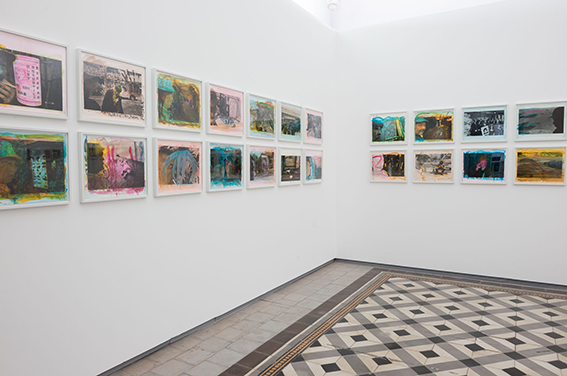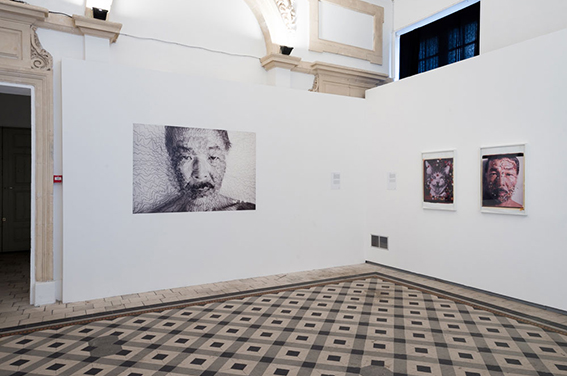PHOTOGRAPHY EXHIBITION OF THE YEAR
WILLIAM EGGLESTON PORTRAITS – PHOTOGRAPHY EXHIBITION OF THE YEAR
The National Portrait Gallery’s Eggleston show raised many issues — about the history of photography, the nature of portraiture and so much more — that it was a natural choice to be our photography exhibition of the year, says Eliza Williams
What makes for an exhibition of the year? The work must be of the highest quality, of course, but the show should also have that elusive aspect, the mysterious something that stays with you long after you’ve left the gallery space. In the case of a historical show, we would also expect to learn something new about the work, and discover a different perspective on the artist.
William Eggleston Portraits, held at the National Portrait Gallery in London from July 21 until October 23, achieved all these elements. Its reviews were ecstatic from the off. “Momentous, trivial, marvellous,” said Adrian Searle in the Guardian, finishing his review by saying simply, “What a great show.” “Devastatingly brilliant,” wrote Louisa Buck in the Telegraph, while Karen Wright in the Independent proclaimed it “confirms his importance”.
Many critics talked of the images lingering with them, and of the complexity held within what are seemingly straightforward shots. “Time and again, Eggleston shows us that a picture of a person is never a simple thing,” said Chris Waywell in Time Out, while Wright continues in the Independent: “Photography can capture a moment, and Eggleston does not just chronicle events but delivers images that are ambiguous, allowing many possible interpretations.”
![]()
Eggleston is not known as a portraitist, and in fact this is the first ever show to concentrate on this aspect of his work. It worked brilliantly, perhaps due to the general excellence of his photography, but also because, within a fairly small show of around only 100 images, curator Philip Prodger was able to bring forth all the themes and questions that have followed Eggleston b throughout his career – some of them doggedly – and examine them in a new light.
For Prodger, Eggleston’s work raises questions over the very nature of what makes a portrait. “Eggleston’s photography strikes some as ambivalent and impersonal, insufficiently humane to qualify as ‘portraiture’,” he writes in the exhibition catalogue. “This in itself is interesting, for it makes us look uncomfortably at some of the presumptions on which portrait practice is built. Photographic portraiture gravitates towards likeness – looking at a clear, head-and-shoulders photograph of a person with a known biography at an intimate distance is meant to reveal something about them, to provide insight. It is a romantic idea, ultimately: to look into the eyes of a sitter so that we might peer into their soul. Yet who is to say that at that moment, in that place, from that distance, at that angle, a photograph tells us anything at all about what drives a person, what shapes them, how they think? Or whether such things even matter. Eggleston is the antidote to such over-reaching conceits.”
![]()
The show features photographs stretching back to the 1960s and its subjects are a mix of family members and friends – some of whom are famous figures – as well as strangers that Eggleston shot on the street. His works are usually displayed without titles and descriptions though Prodger persuaded him to forego this habit for the NPG show, and, where known, identities are revealed, as well as often considerable context.
We are taken into Eggleston’s childhood, via photographs of the family’s help, who became surrogate parents to him while his parents were away. Intriguing characters abound in his later pictures too, framed by Eggleston in a way that speaks always of a wider, unknown narrative. It’s easy to see why he’s been so influential on filmmakers. Writing in the catalogue, director Sofia Coppola sums it up thus: “So many people take those simple snapshots of life, but there’s something about Eggleston that no-one can match. So many of his images I’ve seen over the years stay with me, like a pastel memory from another time.”
Some of the real stories revealed in the show surpass any that could be invented, however. TC Boring, an “eccentric dentist” that Eggleston knew, is shown standing naked in a bright red room, its walls scrawled with text. It turns out this is the room where Eggleston’s famous ‘red ceiling’ image, which focuses on a light fitting, was taken, but the caption also explains Boring’s later fate, which was to be murdered, with his house set on fire.
Other captions are downright gossipy. One painterly photo of two young women on a sofa turns out to be of Eggleston’s cousin Lesa Aldridge and her friend Karen Chatham. According to the caption, Aldridge was comforting her friend who had been rejected by the singer Alex Chilton of Box Tops/Big Star fame, who was also a neighbour of Eggleston (and appears in another portrait in the show). It went on to say that Aldridge then took up with Chilton herself and that their rocky relationship inspired many of his songs.
![]()
Beside another image, of Eggleston’s girlfriend Leigh Haizlip in tears, we find the caption speculating on the cause, and wondering if it was down to the photographer himself. There’s a risk that these kinds of ponderings and insights could distract from the photographs, or, perhaps worse, fix them in a certain time and place. But Eggleston’s work, by its sheer force, always rises above the trivialities, making them enjoyable to discover rather than interfering with the work.
In an interview with Prodger from 2015, which is included in the catalogue, Eggleston’s belief in his work as being beyond a specific setting is clear. “I do not a bit call myself a documentary photographer because I do not feel associated with people and their problems every day. I’m not [the photo agency] Magnum.”
“So many people take those simple snapshots of life, but there’s something about Eggleston that no-one can match,” Sofia Coppola
The same interview reveals Eggleston’s shooting style, which is quick and anonymous: “You know, it happens so fast, they don’t even know it.” One of the criticisms that has been levelled at him over the years is that his work is just throwaway snapshots. As Adrian Searle points out in his Guardian review, this accusation seems patently ridiculous now. “Eggleston’s photography has been derided for its ordinariness, for its compositional blankness, even for its use of colour. This now seems absurd.”
![]()
For what ‘snapshots’ they are, if anyone insists on still calling them so. In a world that is now saturated with imagery, where many of us share our photos daily, if not hourly, it is impossible not to be struck by just how keen and clear Eggleston’s eye is. “For most people, ‘just taking the picture’ would result in tedious clichés,” writes Sarah Kent in theartsdesk.com, “but Eggleston has an uncanny knack of spotting those sublime moments when random elements cohere to make the ordinary seem strange or beautiful.”
The other controversy most associated with Eggleston is his use of colour. Alongside contemporaries including Joel Meyerowitz and Stephen Shore, Eggleston pioneered the use of colour in art photography, and caused outrage in 1976 with a show of colour works at the Museum of Modern Art in New York, which was cited by the New York Times at the time as “the most hated show of the year”.
Like the complaints about snapshots, the idea of colour photography being so shocking seems quaint nowadays. The show at the NPG tracks Eggleston’s journey from black and white through to using colour, and contains many works created using the complex ‘dye transfer’ process that he famously favoured. Originally used for commercial purposes due to the exceptional depth of colour that it produces, Eggleston spotted the potential of dye transfer in art photography and the works produced here using it truly sing.
Eggleston’s work in many ways tracks the progress of our acceptance of photography, in all its varied forms, as art. And while the old complaints about his work are revisited here – they have to be, for historical purposes if nothing else – it feels that what shines out is his status as an ‘artist’, not a ‘photographer’.
“Duchamp demonstrated how a thing can be thought of as something other than what it appears to be,” writes Prodger in his catalogue essay. “Eggleston took this a step further, by showing that the camera, with its unparalleled capacity to record information in exacting detail, does not have to be used for representational purposes, nor do photographs have to be taken at face value.”
Near the end of the 2015 interview in the catalogue, Prodger and Eggleston muse on how people react to exhibitions, and the lack of control that artists and curators have over this. “In terms of exhibitions, I’ve come to appreciate that people enter them with different levels of information and they get different things out of them,” says Prodger. “Some people will see your show, and they’ll say, ‘There are some interesting, pretty pictures’, and leave it at that.”
“You know, I compare it to this,” replies Eggleston. “Different people have different reactions to certain drugs. One will kill one person while another person has the same drug and they feel better.”
In this instance, with this show, it seems clear that the Eggleston medicine worked for the good.

